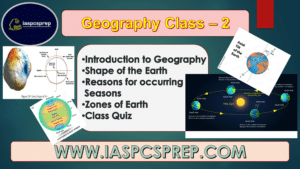| Geography Class-2 PDF |
[pdf-embedder url=”https://www.iaspcsprep.com/wp-content/uploads/2024/03/Geography-Class-2.pdf” title=”Geography (Class-2)”]
The link of PDF of this Geography Class-2 is given below the explanation of the class, you can download the PDF by going below.
Geography Class-2
In this Geography Class-2, we will discuss about the Geography, Shape of Earth, Reasons for occurring Seasons etc.
Topics to be covered in this Article :-
- Introduction to Geography
- Shape of the Earth
- Reasons for occurring Seasons
- Zones of Earth
Geography
The word “Geography” is derived from two Greek words :- “Geo” and “Graphy”. Geo means Earth and Graphy word comes from
the word “Graphine” – means “to describe”.
∴ Geography means “the description of Earth”.
In simple terms, Geography is all about learning and understanding our planet Earth—its land, water, weather, and the people and animals that live on it. It’s like exploring a big puzzle, figuring out where things are and why they are there. Geography helps us know more about our world and how we interact with it every day.
Father of Geography : Eratosthenes
Shape of the Earth
The shape of the Earth is best described as an oblate spheroid (Geoid Shape). This means that it’s mostly spherical, like a ball, but slightly flattened at the poles and slightly bulging at the equator. Imagine a ball that’s been squished a bit on the top and bottom. This shape is due to the Earth’s rotation, which causes a slight outward force at the equator and flattens the poles. So, it’s kind of like a slightly flattened ball. That’s why it’s called an oblate spheroid.
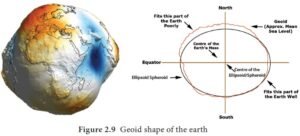
Reasons for occurring Seasons
There are 2 main reasons for the occurrence of seasons and these are :-
- 1. Revolution of Earth
- 2. Axial Tilt of Earth
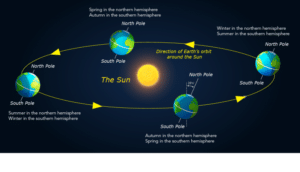
1. Revolution of Earth: Imagine Earth as a passenger on a giant merry-go-round, with the sun as the center. This merry-go-round doesn’t just spin in one place; it travels around the sun in a big loop. This journey is what we call Earth’s revolution. It takes about 365 days for Earth to complete one full trip around the sun.
As Earth moves along its path, different parts of it receive varying amounts of sunlight. When one part is closer to the sun, it gets more direct sunlight, making it warmer. This is what we experience as summer. Meanwhile, when that part moves away from the sun, it receives less direct sunlight, leading to cooler temperatures – that’s winter.
Equinoxes and Solstices: There are four main points in the Earth’s orbit that mark the beginning of each season. These are called the equinoxes and solstices.
- Spring Equinox: Around March 21st, the tilt of the Earth is such that both hemispheres receive about the same amount of sunlight. This marks the beginning of spring.
- Summer Solstice: Around June 21st, the hemisphere tilted towards the sun receives the most sunlight, making it the longest day of the year and the beginning of summer.
- Autumn Equinox: Around September 22nd, the tilt of the Earth is again such that both hemispheres receive about the same amount of sunlight, marking the beginning of autumn.
- Winter Solstice: Around December 21st, the hemisphere tilted away from the sun receives the least sunlight, making it the shortest day of the year and the beginning of winter.
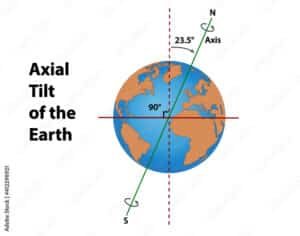
2. Axial Tilt of Earth: Now, let’s imagine Earth as a spinning top that’s slightly tilted to one side. This tilt is what we call Earth’s axial tilt. It’s like if you were to lean a top slightly as you spin it. Earth’s axis is an imaginary line that runs through its North and South Poles, and this tilt causes different parts of the planet to be angled towards or away from the sun as it revolves.
Because of this tilt, the sunlight hits the Earth’s surface at different angles throughout the year. When one hemisphere (half of Earth) is tilted towards the sun, it gets more direct sunlight and experiences warmer temperatures. This is summer for that hemisphere. Meanwhile, the other hemisphere is tilted away from the sun, receiving less direct sunlight and experiencing cooler temperatures – this is winter for that hemisphere.
The occurrence of seasons on Earth is a result of the combined effects of Earth’s revolution around the Sun and its axial tilt. These two factors work together to create variations in sunlight intensity and day length throughout the year, shaping the climate and natural rhythms of life on our planet.
Zones of Earth
The Earth is divided into several distinct climatic zones based on latitude and other geographical factors. These zones play a crucial role in determining the weather patterns, biodiversity, and ecosystems across the planet. These zones are as follows:-
1. Polar / Frigid Zones:
-
- Located near the North and South Poles, extending from approximately 66.5 degrees to the respective poles.
- Characterized by extremely cold temperatures, with long winters and short, cool summers.
- Vegetation is sparse, consisting mainly of mosses, lichens, and small shrubs. Animal life includes species adapted to cold conditions, such as polar bears, seals, and penguins.
2. Tropical / Torrid Zone:
-
- Situated near the equator, between the Tropic of Cancer (23.5 degrees north) and the Tropic of Capricorn (23.5 degrees south).
- Experiences consistently high temperatures throughout the year, with little variation between seasons.
- Rich biodiversity, with lush rainforests, diverse plant species, and a wide array of animal life including tropical birds, monkeys, and reptiles.
3. Temperate Zones:
-
- Found between the tropics and the polar regions, roughly from 23.5 to 66.5 degrees north and south of the equator.
- Moderate temperatures with distinct seasons: warm summers and cool winters.
- Diverse vegetation including deciduous and coniferous forests, grasslands, and mixed forests.
- Supports a wide range of wildlife including deer, bears, wolves, and various bird species.
4. Subtropical Zones:
-
- Located adjacent to the tropical zones, roughly between 23.5 and 35 degrees north and south of the equator.
- Characterized by warm to hot temperatures year-round, with relatively mild winters.
- Vegetation includes a mix of tropical and temperate species, with areas of grasslands, shrubs, and scattered trees.
- Wildlife is diverse, with species adapted to both tropical and temperate conditions.
These zones play a crucial role in shaping the Earth’s climate, weather patterns, and ecosystems. They influence everything from the distribution of plant and animal species to human activities and cultures. Understanding these zones is essential for comprehending the complex dynamics of the Earth’s biosphere.
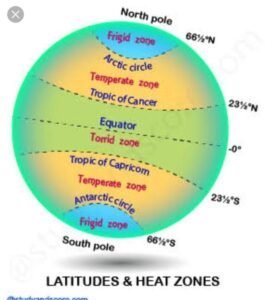
Previous Year Questions
Q1. On 21st June, the sun (2019)
a) does not set below the horizon at the Arctic circle.
b) does not set below the horizon at the Antarctic Circle.
c) shines vertically overhead at noon on the Equator.
d) shines vertically overhead at the Tropic of Capricorn.
Explanation: 21st June is the longest day in the Northern Hemisphere, technically this day is referred to as “Summer Solstice”. On 21st June, the Tropic of Cancer is tilted towards the sun i.e. the sun is always above the horizon and does not set below the horizon at the Arctic Circle. After the summer solstice, the sun starts to sink towards the horizon. As the rays of the sun fall directly on the Tropic of Cancer, the northern hemisphere experience more heat.
Q2. Variations in the length of daytime and night-time from season to season are due to (2013)
a) the earth’s rotation on its axis.
b) the earth’s revolution round the sun in an elliptical manner.
c) latitudinal position of the place.
d) revolution of the earth on a tilted axis.
Explanation: Variations in the length of daytime and night-time from season to season are due to the “revolution of the Earth on a tilted axis”. Our earth is revolving around the sun in on elliptical orbit, and one complete revolution around the sun takes the time period of one year. During this one year long revolution process, the distance between the earth and sun changes continuously, because there is no constant diameter of the elliptical orbit and this changes of distance are the main reason behind the change of day time and night-time expansions.
The above 3 options (a), (b) and (c) does not directly affect the variations in the length of daytime and night- time from season to reason.
Class Quiz
Q1. The Earth is best described as which of the following shapes?
a) Perfect sphere
b) Oblate spheroid
c) Cube
d) Cylinder
Q2. Match the column:

Codes:
a) A-1, B-2, C-3
b) A-2, B-3, C-1
c) A-3, B-1, C-2
d) A-1, B-3, C-2
Q3. Which geographic zone is characterized by cold temperatures year-round and long periods of darkness in winter?
a) Tropical Zone
b) Temperate zone
c) Polar Zone
d) Equatorial zone
Q4. Match the column:

Codes:
a) A-3, B-4, C-1, D-2
b) A-3, B-4, C-2, D-1
c) A-4, B-3, C-1, D-2
d) A-4, B-3, C-2, D-1
Q5. The shape of the Earth was first determined by:
a) Aristotle
b) Nicolaus Copernicus
c) Galileo Galilei
d) Eratosthenes
This is all about the Geography Class-2. In next class, we will discuss about the Atmosphere, Origin of Atmosphere, Structure of Atmosphere etc.
| Some Important Links | |
| Geography Class-2 YouTube Short Video |
Click Here |
| Download Geography Class-2 PDF | Click Here |
| If you are satisfied with our website iaspcsprep.com, Please like and share with more people. | |
| Subscribe our YouTube Channel |
Subscribe Now |
| Join our Telegram Channel | Join Now |
| Follow our WhatsApp Channel | Follow Now |
| Join our WhatsApp Group for PDF | Join Now |
| Follow our Facebook Page | Follow Now |
| For any Query and Feedback, Contact Us at – study@iaspcsprep.com. | |

